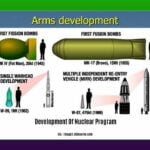Get ready to dive into the wild world of internet memes! Imagine Thomas the Tank Engine, the beloved children’s train, suddenly becoming a nuclear bomb. That’s what the “Choo-Choo! All Aboard the Meme Train: Unpacking Thomas the Thermonuclear Bomb” meme is all about. Join us for a fun and thought-provoking ride as we explore how this innocent character turned into an unstoppable force of destruction, and what it teaches us about the strange and wonderful world of online culture.
Thomas as a Thermonuclear Threat
Okay, picture this: Thomas the Tank Engine, the cheerful little train we all know and love, but with a twist. He’s packing some serious heat—we’re talking a mini mushroom cloud kind of heat. That’s the essence of “Thomas the Thermonuclear Bomb,” a meme that’s as wild as it sounds.
This bizarre yet hilarious meme emerged in 2018 thanks to YouTuber Umami, who decided to merge the wholesome image of Thomas with the unsettling image of a nuclear explosion. The result? An instant meme was born.
But what makes this unlikely pairing so effective? The answer likely lies in the sheer absurdity of it all. Humans are naturally drawn to humor found in unexpected places, and witnessing our childhood icon transformed into a walking weapon of mass destruction certainly fits that bill.
Some speculate that this meme might also tap into deeper anxieties about the state of the world. We exist in an era defined by rapid technological advancement and the ever-present threat of global conflict. Could “Thomas the Thermonuclear Bomb” be a way for us to process these fears, albeit through dark humor?
And process it we have. This meme has exploded across the internet, evolving far beyond its humble beginnings. Image macros, remixed videos, even fan art—if you can imagine it, someone has probably created it with a Thermonuclear Thomas spin. This remarkable evolution showcases the internet’s incredible power to catapult a simple idea into a full-blown cultural phenomenon.
Ultimately, “Thomas the Thermonuclear Bomb” serves as a prime example of how memes can reflect the anxieties and humor of a particular time. It reminds us that even in a world that can feel overwhelming, we still seek ways to laugh and find meaning, even if it involves a nuclear-powered train.
[Did you know that Chuck Bednarik] played for the Philadelphia Eagles for 10 seasons? Learn more about his career with the Eagles here.
Tsar Bomba: Deconstructing the Most Powerful Bomb Ever Recorded
The “Thomas the Thermonuclear Bomb” meme inevitably begs the question: what is the most powerful bomb ever detonated? The answer is a chilling reminder of the destructive capabilities humans possess: the Tsar Bomba.
This Soviet-engineered monstrosity, officially designated as the AN602, was far more than just another bomb. It was the undisputed king of explosions, dwarfing even the devastating bombs dropped on Japan during World War II. Designed to unleash an unfathomable 50 megatons of TNT, the Tsar Bomba’s power is difficult to comprehend. To put it into perspective, it was three times more powerful than all the explosives used in World War II combined.
On October 30, 1961, the world witnessed the Tsar Bomba’s terrifying power firsthand. Detonated over Novaya Zemlya in the Arctic Ocean, the explosion sent shockwaves that reverberated across the globe. The fireball alone was visible for over 600 miles, while the mushroom cloud, a chilling column of smoke and debris, soared 40 miles into the atmosphere—five times higher than the cruising altitude of a commercial airliner.
The sheer force of the detonation created a shockwave that circled the planet three times, even registering as an earthquake measuring between 5.0 and 5.25 on the Richter scale. Astonishingly, the Soviets initially intended to make the Tsar Bomba even more powerful, aiming for a 100-megaton blast. However, they ultimately reduced the yield to mitigate the potentially catastrophic radioactive fallout.
[Evy Mage’s] story is one of courage and determination. Read more about her journey to become the first African American woman to graduate from Wake Forest University.
Unveiling the Global Thermonuclear Arsenal
The sheer power of the Tsar Bomba leads to another pressing question: how many thermonuclear bombs, also known as hydrogen bombs, actually exist? Obtaining an exact figure is a near-impossible task. Governments understandably keep this information highly classified. However, experts estimate that there are currently over 12,000 of these devastating weapons scattered across the globe — a sobering thought, to say the least.
A majority of these weapons belong to the United States and Russia, maintained in a constant state of readiness across land, sea, and air. This concentration of power underscores the immense responsibility these nations bear in preventing a global thermonuclear catastrophe.
Why is Counting So Difficult?
The lack of a precise count on thermonuclear weapons might seem surprising, but it boils down to national security concerns. No nation wants to reveal its hand in this high-stakes game, making an official, public list an impossibility.
Organizations such as the Bulletin of the Atomic Scientists, SIPRI, and the Federation of American Scientists utilize creative methods to develop their estimates. This includes analyzing public records of nuclear materials, deciphering cryptic statements from government officials, and even scrutinizing satellite images of suspected bomb-making facilities and storage sites. It’s a complex puzzle with many missing pieces.
A World on a Knife’s Edge
The destructive potential of even a single thermonuclear explosion is almost beyond comprehension. We’re talking immediate and horrific consequences, including massive explosions, intense heat, deadly radiation, and long-lasting environmental devastation.
The threat extends beyond intentional use. There’s always the risk of an accident, a miscalculation, or even unauthorized access. These chilling possibilities highlight the precarious position humanity finds itself in—sitting on a stockpile of weapons capable of unimaginable destruction.
The Struggle for Disarmament
Thankfully, efforts are underway to reduce the global thermonuclear stockpile. The Treaty on the Non-Proliferation of Nuclear Weapons (NPT) has played a crucial role in limiting the spread of these weapons, though challenges remain in terms of enforcement and global participation. Agreements like New START between the US and Russia, aimed at arsenal reduction, offer a glimmer of hope. However, geopolitical tensions often hinder progress toward meaningful disarmament.
The existence of thermonuclear bombs serves as a stark reminder of the duality of our world—a world where immense destructive power coexists with efforts to control and ultimately eliminate it.
[Ruby Bridges’ timeline] is a powerful reminder of the struggles faced by African Americans during the Civil Rights Movement. Learn more here about her life and legacy.
The Dawn of the Hydrogen Bomb
Given the sheer destructive power of the hydrogen bomb, it’s natural to wonder about its origins. Who was responsible for ushering in this terrifying new era of weaponry?
The answer is the United States. On November 1st, 1952, they detonated a device codenamed “Mike” over Enewetak Atoll in the Marshall Islands. This wasn’t just another atomic bomb like those used in World War II. “Mike” was a hydrogen bomb, ushering in an entirely new level of destructive capability.
This historic test, part of the US military’s Operation Ivy, took place under the presidency of Harry S. Truman. With the successful detonation of “Mike,” the world was forever changed. The knowledge that such devastating power was attainable sparked widespread fear and ignited a global debate about the very real possibility of a full-blown nuclear war.
B41: The Peak of US Nuclear Might
While the Tsar Bomba remains the most powerful bomb ever detonated, the United States developed its own monster: the B41 thermonuclear bomb. This three-stage thermonuclear weapon, boasting a 25-megaton yield, was the most powerful weapon ever in the US arsenal — a testament to the terrifying heights of the Cold War arms race.
Developed in the early 1960s, the B41 represented a significant escalation in the ongoing nuclear standoff between the US and the Soviet Union. The B41, with its ability to unleash over 1,500 times the destructive force of the Hiroshima bomb, served as a chilling reminder of the stakes at play.
Thankfully, despite its unimaginable power, the B41 was never used in combat. In fact, the US decommissioned all B41 bombs by 1976, marking a shift in nuclear strategy away from massive single warheads towards more tactical and “usable” nuclear weapons.
The B41, though a relic of a bygone era, stands as a potent reminder of humanity’s capacity for destruction. It serves as an enduring symbol of the immense responsibility we bear in ensuring that such power is never unleashed again.
- Unlock 6000+ words beginning with he: A comprehensive analysis - April 20, 2025
- Mastering -al Words: A Complete Guide - April 20, 2025
- Master Scrabble: High-Scoring BAR Words Now - April 20, 2025
















